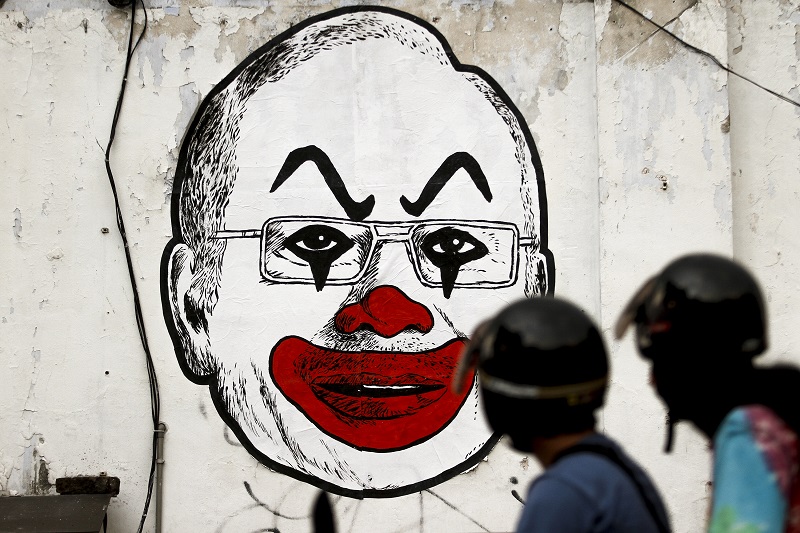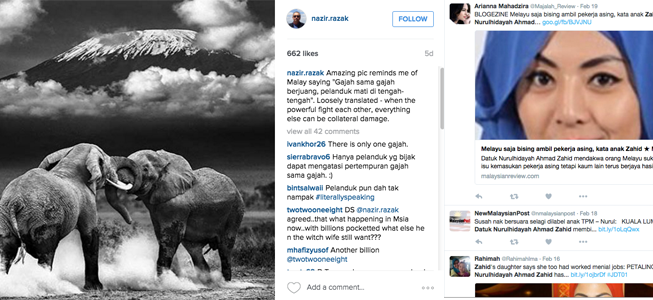 When the authorities warned activist and graphic designer Fahmi Reza over his ‘clown’ campaign, other artists shared their artwork featuring the prime minister as a clown. – The Malaysian Insider pic by Seth Akmal, March 13, 2016.Before the advent of social media, what the prime minister’s brother thought about a certain issue or his take on the country’s socio-political situation would have been unlikely be known by the public, unless a statement was issued and disseminated through the press.
When the authorities warned activist and graphic designer Fahmi Reza over his ‘clown’ campaign, other artists shared their artwork featuring the prime minister as a clown. – The Malaysian Insider pic by Seth Akmal, March 13, 2016.Before the advent of social media, what the prime minister’s brother thought about a certain issue or his take on the country’s socio-political situation would have been unlikely be known by the public, unless a statement was issued and disseminated through the press.
But web platforms, such as Instagram, Twitter and Facebook, have changed these dynamics, allowing the public to follow the likes of CIMB Group chairman Datuk Seri Nazir Razak, younger brother to Datuk Seri Najib Razak.
Nazir, and Deputy Prime Minister Datuk Seri Zahid Hamidi’s daughter, Datuk Nurulhidayah Ahmad Zahid, are now the subject of public curiosity and speculation.
Both Nazir and Nurulhidayah have garnered a mass Instagram following, with Nazir posting pictures accompanied by lines from popular television series or movies as cryptic commentary on the country’s state of affairs, while Nurulhidayah often defends her father.
Others making social media headlines include singer-actress Soo Wincci, for her YouTube video demanding democratic reforms and Najib’s resignation, and more recently, activist and graphic designer, Fahmi Reza, who started the #KitaSemuaPenghasut (We are all seditious) campaign featuring artwork of Najib as a clown.
Empowerment
Media experts observing this phenomenon chalk the possibility down to growing disdain and suspicion of traditional news outlets, viewed as skewed and stifled by the government or media ownership controls.
In a highly censored society, such as Malaysia, social media becomes a useful platform to express oneself and voice opinions, said Dr Joanne Lim, Monash University Malaysia's associate professor of Communications and Media Studies.
She said the appeal could also be because of fading distinctions between producers and consumers or users of content, making them known as the hybrid term “produsers”.
“People turn to social media due to the simple yet very significant notion of ‘participation’. On social media, users also have the opportunity to become producers, hence the term ‘produser’.
“The ordinary person can affect change, mobilise a community, and gather a following by producing and sharing videos on YouTube, recording and posting podcasts, and disseminating images on Flickr, Tumblr etc.
“To an extent, this can be empowering,” Lim said.
Zaharom Nain, Professor of Media and Communication Studies University of Nottingham Malaysia, said social media users’ expressions, which centred around governance and leadership, could also arise out of genuine concern for the state of the country.
“I would assert that like many other Malaysians, these personalities are shocked, indeed appalled, at how the country is being (mis)governed, how those in power are blatantly covering their alleged misdeeds… how notions of ‘right’ and ‘wrong’ have been and continue to be turned on their heads.
“Indeed, there seems to be no sense of shame or ethics any more in the corridors of power, and this is something that many, including so-called personalities, rightly, are very concerned about.
“It is this shocking situation and the gall of those doing all this that have fired up these personalities to speak out.”
What makes a post viral
Zaharom said more in-depth work was required to analyse “trending” and viral online posts. However, the interactive factor of social media, in the form of “like” and “share” buttons could play a significant role.
Context was also important, he said, as the more prominent the social media personality, the higher the degree of popularity.
“Of course, a combination of ‘Who’ (personality) and ‘What’ (subject matter) would add to the possibility of the message becoming viral.
“Indeed, ‘followers' would less likely share a message by Nazir about his cat than they would a critical comment from him about the economy,” he said.
Asia’s top debater, Syed Saddiq Syed Abdul Rahman, is no stranger to using social media to start discussions on topics and issues.
He already has a significant amount of social media interest before he raised eyebrows with his Facebook post in October last year, denouncing Najib as a “national disgrace”.
The 23-year-old law student, however, said he noticed traction picking up on his posts whenever he touched on subjects related to politics and government reforms.
“Primarily, I believe people tend to share more of my posts when my views agree with theirs.”
For rights activist and designer provocateur, Fahmi Reza, social media has been his platform to promote activism since 2009.
However, it was his latest posters of a “clown” Najib which became viral and received the most publicity after authorities reacted by censuring his work.
“I think the government’s response to censor and warn against this particular poster gave it the most extreme attention.
“When I put up the poster and received a warning from the Police Cyber Investigation Response Centre (PCIRC), I never expected other graphic artists to react by coming up with their own posters.
“They were basically saying there’s nothing wrong with drawing the prime minister as a clown, this is the way we express dissatisfaction and we are going to do it too, in solidarity,” said Fahmi, whose “clown” campaign is targeted at the Sedition Act with the tagline “Dalam negara yang penuh dengan korupsi, kita semua penghasut” (In a country full of corruption, we are all seditious).
It was in response to the attorney-general’s decision to close investigations into the RM2.6 billion banked in Najib’s accounts.
Not impressed, the Twitter account for the police’s Cyber Investigation Response Centre (@OfficialPcirc) warned Fahmi that he was being watched.
Fahmi also viewed social media as a factor which created more awareness despite tight reins and censorship on both mainstream and alternative press.
“Previously, news could be restricted because of control on the press but there’s no stopping social media.”
That may well be the boon of social media in spreading awareness about political and civil rights, but is also a point of caution, especially for journalists.
Zaharom, the media professor, said it would be lazy and a lack of initiative on the part of newsmen if they did not bother to check the accuracy of these views or seek them out from people in the first place.
“Instead, they just scour or comb social media for these thoughts, opinions and ideas.
“Journalists must check for the factual accuracy of what they report before they publish. Journalism 101.” – March 13, 2016.
 CIMB Group chairman Datuk Seri Nazir Razak and Deputy Prime Minister Datuk Seri Zahid Hamidi’s daughter, Datuk Nurulhidayah Ahmad Zahid, have a massive following on Instagram. – The Malaysian Insider pic, March 13, 2016.
CIMB Group chairman Datuk Seri Nazir Razak and Deputy Prime Minister Datuk Seri Zahid Hamidi’s daughter, Datuk Nurulhidayah Ahmad Zahid, have a massive following on Instagram. – The Malaysian Insider pic, March 13, 2016.

Comments
Please refrain from nicknames or comments of a racist, sexist, personal, vulgar or derogatory nature, or you may risk being blocked from commenting in our website. We encourage commenters to use their real names as their username. As comments are moderated, they may not appear immediately or even on the same day you posted them. We also reserve the right to delete off-topic comments